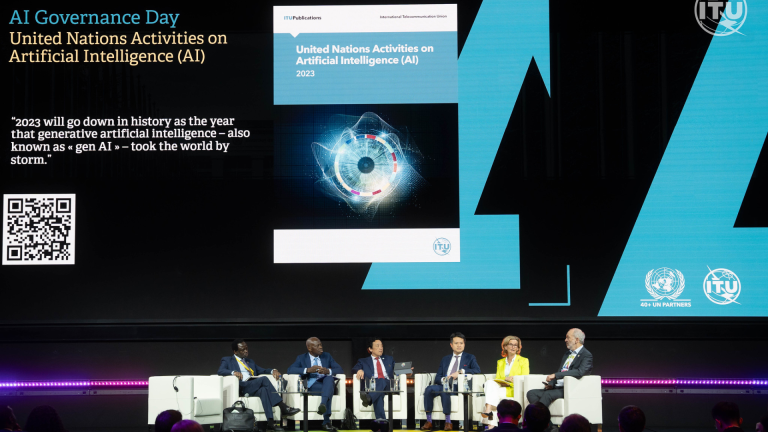Revolutionizing Disaster Response: The Power of Autonomous Robots
Harnessing AI in Autonomous Robots for Disaster Management
Driven by artificial intelligence and sophisticated sensors, autonomous robots possess the capability to navigate through intricate and perilous environments, gather essential data, and execute designated tasks with minimal human oversight. These robots emerge as invaluable resources during disaster response operations, especially when human access is restricted or deemed unsafe. Leveraging autonomous robots allows responders to mitigate risks to human safety and enhance the efficacy of disaster management operations. These cutting-edge machines can quickly evaluate and collect data from affected zones, pinpoint survivors, identify potential dangers, and relay real-time information to support informed decision-making.
Insights from the AI for Good Global Summit 2023
During the panel discussion titled “Autonomous Robots for Disaster Management” at the AI for Good Global Summit 2023, experts highlighted the tremendous toll of disasters, revealing that in 2022 alone, over 400 disasters occurred worldwide, resulting in the tragic loss of 31,000 lives and an overwhelming economic burden exceeding $220 billion in direct costs. This highlights an urgent need for innovative technological solutions in disaster response.
The Evolution of Robots and Drones in Disaster Response
The introduction of robots and drones for disaster management dates back to 2001, particularly noted for their deployment in Miami following a building collapse. Initially designed for navigation and autonomy, these technologies have progressed far beyond their original intent, now being utilized for a variety of rescue missions, showcasing their remarkable adaptability and effectiveness.
Following Hurricane Katrina in the United States, drones became an essential resource. Yet, their integration faced obstacles due to a top-down, policy-driven adoption process, necessitating collaboration among local agencies. Addressing these challenges is critical, as Robin Murphy, Professor at Texas A&M University, emphasized the necessity of focusing on human-centered solutions. The objectives have now expanded to include land utilization, flood mitigation, and overall recovery, drawing increased interest from insurance companies highlighting the amplified vulnerability of certain demographics and the compounded challenges of recovery efforts.
“Drones have been used after Hurricane Katrina in the United States and are at heart resource because the adoption cycle is very top down – very policy driven and hard to get through,” shared Robin Murphy, Professor of Computer Science and Engineering at Texas A&M University.
Revolutionizing Disaster Mitigation with Intuitive Technology
In the realm of drone technology, Dario Floreano, Director of the Laboratory of Intelligent Systems at EPFL, is leading an intriguing initiative focused on guiding drones through buildings and confined spaces, ingeniously presenting disaster mitigation as an appealing application. The lab’s drones are not merely inspection devices; they are crafted to develop communication frameworks in areas where conventional infrastructure is absent. The vision is to offer a seamless experience that negates the need for extensive training. Picture a swarm of drones effortlessly maneuvered by a single individual using natural body movements—this paradigm shift in disaster response is groundbreaking. Switzerland, at the forefront of innovation, embraces the exploration of technology’s potential before establishing regulations, illuminating the future of intuitive disaster mitigation.
With an eye toward disaster resilience, Floreano’s team aspires to unify technology created for various purposes for the collective good. Their endeavors go beyond mere research as they prioritize establishing communication lines that support and inform rescue operations. By pushing the limits of drone capabilities, the next significant step is to render this technology more user-friendly, increasing both accessibility and efficiency. This revolutionary approach urges us to rethink how disaster mitigation can leverage versatile technologies originally intended for disparate applications.
“The aim is that the drones will not require training from a person flying it, making it a more immersive experience. Using a swarm of drones that can be controlled by a single human using natural motion of the body,” noted Dario Floreano, Director of the Laboratory of Intelligent Systems at EPFL.
Enhancing Data Integration and Communication in Disaster Response
In a world inundated with data, effective communication is paramount in disaster response. The staggering volume of information produced during emergencies presents significant hurdles for nations, making it increasingly vital to create systems that unite data across various devices. This interconnected methodology ensures that critical information reaches those in need, enabling a more swift and coordinated response to emergencies.
Furthermore, Dominick Romano, Founder of Drainpipe.io, emphasizes the necessity for nighttime emergency rescue training that incorporates data upload into computers and simulation of disaster scenarios. He points out the essential difference between data and information, stressing that information only arises when significance is assigned to the amassed data. As complexities grow, Romano argues for a more meaningful approach to data management, asserting that technology alone cannot suffice—grasping the events unfolds requires attaching meaning to the data, especially in logistics and operational strategy.
“Data is not information, until it is associated with meaning,” emphasized Dominick Romano, Founder of Drainpipe.io.
Challenges and Collaborative Efforts in Disaster Management
Reflecting on the contemporary technological landscape, Darrell Etherington, Managing Editor at TechCrunch and session moderator, acknowledged substantial advancements in our technological capabilities but also highlighted areas ripe for improvement in disaster management. Etherington raised the question: What primary challenges hinder the integration of robots or drones in disaster response? He underscored the essence of collaborative efforts, advocating that progress should evolve in harmony with individuals and institutions. Recognizing the complexities tied to deploying autonomous systems in disaster contexts is essential, as emphasizing the need for a collective call to action for the tech community to foster partnerships that extend beyond mere innovation to a comprehensive understanding of the real-life challenges inherent in disaster response.
The Path Forward: Transformative Technology in Disaster Response
In light of the increasing difficulties posed by disasters, merging autonomous robots and drones alongside advancements in data management and communication emerges as a pivotal force in enhancing disaster response. AI-powered robots, equipped with advanced sensors, provide vital solutions for navigating hazardous terrains, diminishing risks to human lives, and enhancing the overall efficiency of disaster management operations. The considerable impact of recent disasters reinforces the pressing need for innovative technological solutions, and the integration of drones and robots plays a critical role in lessening both loss of lives and economic devastation.
The emphasis on meaningful data management highlights the importance of not merely collecting data but transforming it into actionable insights, underscoring the necessity for comprehensive systems that connect and interpret data for informed decision-making. As we navigate the convergence of technology, policy, and human-centered strategies, the collaborative efforts discussed herein illuminate a path to a more resilient and responsive future in disaster management. From autonomous robots traversing perilous terrains to drones establishing communication in tight spaces, the integration of data for actionable insights represents the keys to fundamentally transforming disaster response on a global scale.






